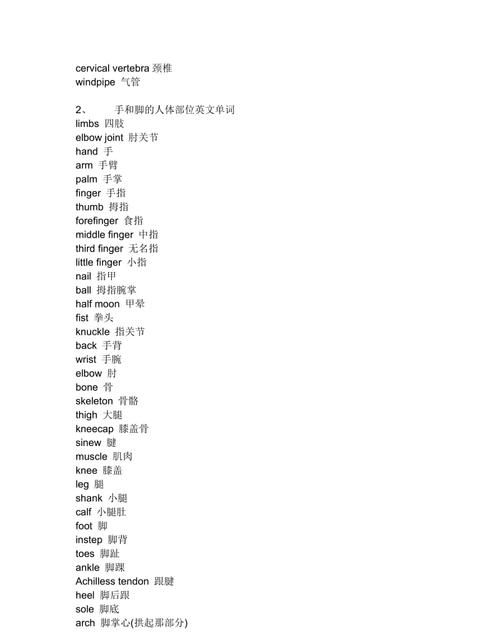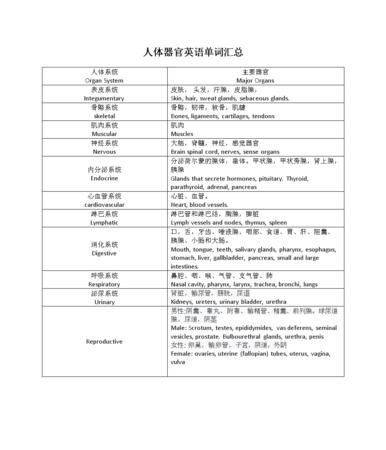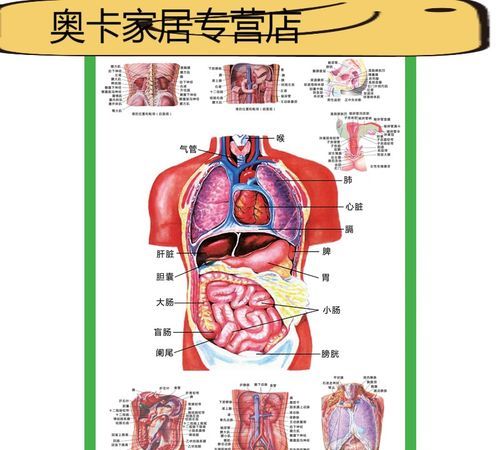本文目录
各种人体部位的英文单词大全
给我你邮箱,发你

【50分起】 关于体检的单词 答案好的话分不是问题
加分阿
***/gview?a=v&q=cache:R2vmuGWwCWkJ:***/zl/sh_l1/Health_Checkup_Promotion.pdf+health+checkup+report&hl=zh-CN&gl=cn
还有:
普及教育 universal education
义务教育 compulsory education; free education
学前教育 preschool education
初等教育 elementary education
中等教育 secondary education
高等教育 higher/tertiary education
普遍教育 general education
成人教育 adult education
pavilion :展厅
1.Large and often sumptuous tent
sumptuous:奢侈的,华丽的
1.Rich and superior in quality
Please fast for 10 hours before the screening.
请检查前空腹10小时。
这个 fast 的意思想了好几天才明白,直到我看到I am fasting,(我正在禁食)
glucose 最常见的六碳单糖,又称右旋糖。以游离或结合的形式,广泛存在于生物界。葡萄、无花果等甜果及蜂蜜中
1.A monosaccharide sugar that has several forms; an important source of physiological energy
cholesterol胆固醇
1.An animal sterol that is normally synthesized by the liver; the most abundant steroid in animal tissues
specimen:范例,标本,样品,样
1.An example regarded as typical of its class
2.A bit of tissue or blood or urine that is taken for diagnostic purposes
They collected urine specimen for urinalysis
Eurasian:欧亚的,欧亚人的
1.Relating to, or coming from, Europe and Asia
His mother was Eurasian, and his father Chinese
hypertension:high blood presure
1.A common disorder in which blood pressure remains abnormally high (a reading of 140/90 mm Hg or greater)
close family memeber近亲
diabetes:高血糖,糖尿病(注意这不是复数哦)
1.A polygenic disease characterized by abnormally high glucose levels in the blood; any of several metabolic disorders marked by excessive urination and persistent thirst
Coronary heart disease:冠心病
1.Surrounding like a crown (especially of the blood vessels surrounding the heart)
stroke 中风
fritter:
1.Small quantity of fried batter containing fruit or meat or vegetables
apple fritter :炸苹果片
margarin:人造奶油,
soft roe:鱼白,鱼精
roe:
1.Fish eggs or egg-filled ovary; having a grainy texture
2.Eggs of female fish
peripheral:外围的,外围设备,

谁知道关于人身体部位和内脏的英文单词是什么
头:head
头顶:the top (或:crown)of the head
发:hair of the head
额:forhead
太阳穴:temple
面部:face
颊:cheek
颧骨:cheekbone
眼:eye
眉毛:eyebrow
睫毛:eyelash
眼皮:eyelid
眼球:eyeball
瞳孔:pupil
虹膜:iris
耳:ear
耳膜鼓:ear drum
听道:auditory canal
鼻:nose
鼻孔:nostril
鼻腔:nasal cavity
鼻梁:brdge of the nose
人中:philtrum
口:mouth
唇:lip
舌:tongue
牙:tooth(teeth)
齿冠:crown
齿龈:gum
齿根:root;fang
(牙)珐琅质:enamel
硬腭:hard palate
软腭:soft palate
小舌:uvula
扁桃体:tonsil
声带:vocal cords
咽头:pharynx
下巴:chin
颚,颌:jaw
颚骨:jawbone
颈;脖子:neck
吼:throat
咽喉:larynx
项;颈背:nape(或:scruff)of the neck
身躯,躯干:trunk
背:back
肩:shoulder
腋窝:armpit
胸:chest
乳房:breast;thorax
乳头:nipple
腰:waist;loins
肚脐:navel;belly button
腹:abdomen;belly
上腹:the upper abdomen
下腹;the lower abdomen
腹股沟:groin
臀部:buttocks;hips;bottom;backside
生殖器:genitals;genital organ
肢:limb
臂:arm
上臂:upper arm
前臂:fore arm
胳膊弯:bend (或:crook)of the arm
肘:elbow
腕:wrist
手:hand
手背:back of the hand
手掌:palm of the hand
手指:finger
大拇指:thumb
食指:forefinger;index finger
中指:middle finger
无名指:ring finger
小指:little finger
指甲:finger nail
腿:leg
大腿:thigh
小腿:lower leg;shank
膝:knee
膝关节:knee joint
膝盖骨:kneecap
膝弯:hollow of the knee;back of the knee
腿肚:calf
踝:ankle
足:foot(feet)
脚背:instep
脚掌:sole of the foot
后跟:heel
趾:toe
趾甲:toenail
心脏:heart
肌肉:muscle
胸肌:pectoral muscle
腹肌:abdominal muscle
三角肌:deltoid muscle
脑:brain
大脑:cerebrum
小脑:cerebellum

有关身体部位的英语单词有哪些?
head 头
throat 喉咙, 咽喉
armpit hair 腋毛
nipple 乳头
chest 胸部
pit 胸口
navel 肚脐
abdomen 腹部
private parts 阴部
thigh 大腿
neck 脖子
shoulder 肩
back 背
waist 腰
hip 臀部
buttock 屁股
skull 颅骨, 头盖骨
collarbone 锁骨
rib 肋骨
backbone 脊骨, 脊柱
shoulder joint 肩关节
shoulder blade 肩胛骨
breastbone 胸骨
elbow joint 肘关节
pelvis 骨盆
kneecap 膝盖骨
bone 骨
skeleton 骨骼
sinew 腱
muscle 肌肉
joint 关节
blood vessel 血管
vein 静脉
artery 动脉
capillary 毛细血管
nerve 神经
spinal marrow 脊髓
brain 脑
respiration 呼吸
windpipe 气管
lung 肺
heart 心脏
diaphragm 隔膜
internal organs 内脏
gullet 食管
stomach 胃
liver 肝脏
gall bladder 胆囊
pancreas 胰腺
spleen 脾
duodenum 12指肠
small intestine 小肠
large intestine 大肠
blind gut 盲肠
vermiform appendix 阑尾
rectum 直肠
anus 肛门
kidney 肾脏
bladder 膀胱
penis 阴茎
testicles 睾丸
scroticles 阴囊
urine 尿道
ovary 卵巢
womb 子宫
vagina 阴道
hair 头发
forehead 额
temple 太阳穴
eyebrow 眉毛
eye 眼睛
ear 耳朵
cheek 面颊
nose 鼻子
lip 嘴唇
mouth 口
chin 下巴
wrinkles 皱纹
crow's-feet 鱼尾纹
mole 痣
Adam's apple 喉
freckles 雀斑
dimple 酒涡
pimple 粉刺
tooth 牙齿
uvual 小舌
tonsil 扁桃腺
tongue 舌
decayed tooth 龋齿
gum 牙龈
palate 上牙膛
incisors 切齿, 门齿
canine tooth 大齿
premolars 前齿
molars 后牙
denlture 假齿
mustache 小胡子
beard 山羊胡
whiskers 络腮胡
sidebums 鬓角
almond eye 杏仁眼
double eye 双眼皮
upturned nose 朝天鼻
aquiline nose 鹰钩鼻
snub nose 狮子鼻
bulbous nose 球状鼻
Grecian nose 悬胆鼻
Roman nose 鹰鼻
thumb 大拇指
forefinger 食指
middle finger 中指
third finger 无名指
little finger 小指
palm 手掌
ball 拇指腕掌
nail 指甲
half moon 甲晕
fist 拳头
knuckle 指关节
back 手背
wrist 手腕
elbow 肘
armpit 腋下
thigh 大腿
knee 膝盖
shank 小腿
calf 小腿肚
foot 脚
instep 脚背
toes 脚趾
ankle 踝
Achilles's tendon 跟腱
heel 脚后跟
sole 脚底
arch 脚掌心

以上就是关于人体内脏的英语单词 ,各种人体部位的英文单词大全的全部内容,以及人体内脏的英语单词 的相关内容,希望能够帮到您。
